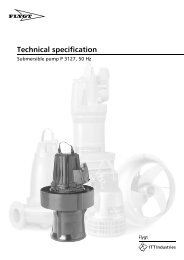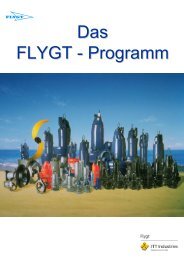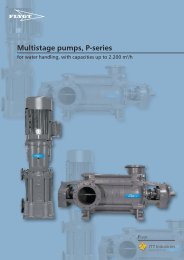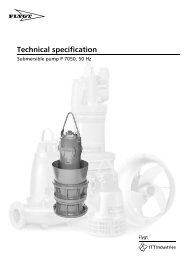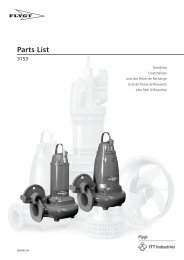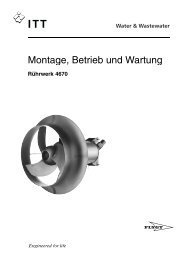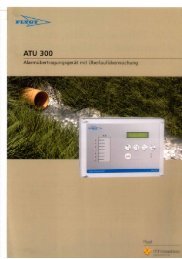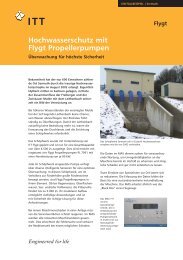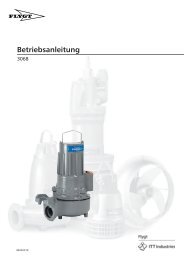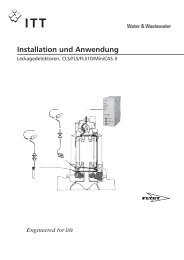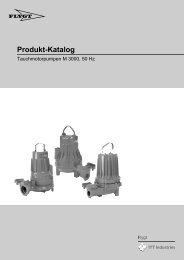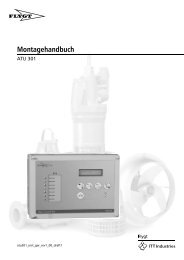Environmental Product Declaration - Environdec
Environmental Product Declaration - Environdec
Environmental Product Declaration - Environdec
Create successful ePaper yourself
Turn your PDF publications into a flip-book with our unique Google optimized e-Paper software.
Flygt 3202.180<br />
Environment <strong>Product</strong><br />
<strong>Declaration</strong>
Table of Contents<br />
Table of Contents<br />
General....................................................................................................................................................2<br />
The company.......................................................................................................................................2<br />
The product..........................................................................................................................................2<br />
Environment performance....................................................................................................................3<br />
Overview...............................................................................................................................................3<br />
Functional unit.....................................................................................................................................3<br />
Allocation..............................................................................................................................................3<br />
System boundaries..............................................................................................................................3<br />
Manufacturing......................................................................................................................................4<br />
Recovery...............................................................................................................................................4<br />
Waste generated.................................................................................................................................4<br />
Resource utilization.............................................................................................................................5<br />
Energy consumption...........................................................................................................................6<br />
Emission................................................................................................................................................6<br />
Miscellaneous.........................................................................................................................................8<br />
Overview...............................................................................................................................................8<br />
Time of validity.....................................................................................................................................8<br />
Accredited Certification body...........................................................................................................8<br />
References............................................................................................................................................8<br />
Flygt 3202.180 Environment <strong>Product</strong> <strong>Declaration</strong> 1
General<br />
General<br />
The company<br />
The product<br />
Xylem Water Solutions AB is certified according to ISO 14001:2004 and ISO 9001:2000.<br />
The environmental product declaration has been drawn up in accordance with “<strong>Product</strong><br />
Specific Requirements (PSR) – Submersible pumps and mixers” (PSR 2002:5).<br />
This document applies to pump 3202.180. The pump is designed mainly for operation in<br />
pump sumps, i.e. sewage pumping in pumping stations and/or sewage treatment plants.<br />
The pump has a hydraulic power of 20.71 kW and an overall efficiency of 73.6%. The<br />
average weight of the pump is 521 kg.<br />
The pump is equipped with the patented N-technique. The semi open design of the<br />
impeller reduces the risk of clogging and maintains pumping efficiency over longer<br />
periods of time.<br />
2 Flygt 3202.180 Environment <strong>Product</strong> <strong>Declaration</strong>
Environment performance<br />
Overview<br />
Functional unit<br />
Allocation<br />
System boundaries<br />
In order to identify and quantify the significant environmental life cycle phase of Flygt<br />
products an generic LCA was carried out The major findings of this LCA can be found in<br />
Miscellaneous (page 8).<br />
The data and calculations used conform with the "<strong>Product</strong>-Specific Requirements (PSR) -<br />
Submersible pumps and mixers" (PSR 2002:5).<br />
Table 1: <strong>Declaration</strong> of contents, with the quantity of every material specified as a proportion<br />
of the total pump weight in kg, and kg per functional unit.<br />
Material kg %* kg/kW<br />
Casted Iron 348 66.7 16.8<br />
Steel 98.6 18.9 4.76<br />
Aluminium 13.7 2.63 0.663<br />
Copper 16.7 3.20 0.804<br />
Stainless steel 22.4 4.30 1.08<br />
Chloroprene Rubber 6.12 1.17 0.295<br />
Oil 9.00 1.73 0.434<br />
Nitrile rubber 0.08 0.015 0.004<br />
Bronze 0.380 0.073 0.018<br />
WCCR 0.612 0.117 0.030<br />
Polyester 0.85 0.163 0.041<br />
Parts not included** 4.89 0.938 0.236<br />
Total 521 100 25.2<br />
* by weight<br />
** Weight on details that's not included in assessment<br />
Environment performance<br />
The allocation factor for the environmental impact during the production phase is<br />
calculated as the ratio of the product weight to the total produced pump weight for the<br />
relevant factory during one year.<br />
The system boundaries for the LCA that serves as a basis for this EPD is according to the<br />
figure below.<br />
Flygt 3202.180 Environment <strong>Product</strong> <strong>Declaration</strong> 3
Environment performance<br />
Manufacturing<br />
Recovery<br />
Waste generated<br />
For End-Of-Life phase, environmental data only accounts for (generated) waste flows (i.e.<br />
no emissions).<br />
<strong>Product</strong>ion of<br />
raw material<br />
End-of-life<br />
Transport<br />
Manufactoring<br />
in Emmaboda<br />
Transport<br />
Use<br />
The manufacturing phase extends from resource and energy extraction up to and<br />
including the finished product.<br />
Since most of the Xylem Water Solutions Flygt branded products are manufactured in<br />
Emmaboda, Sweden, it is assumed that the pump is manufactured there. The values for<br />
resource utilization, emissions to atmosphere or water, and waste generation caused by<br />
production have therefore been taken from the factory in Emmaboda.<br />
The core of production is casting and machining of products, the components of which<br />
consist of cast iron, and the production of electric motors for the products. The<br />
environmental impact caused by subcontractors has not been included in the analysis.<br />
The materials recovered from the pump are aluminium, chromium, copper, cast iron, steel,<br />
brass, nickel, zinc and plastics. This presupposes that the materials are handed in to a<br />
suitable recycling plant. During the recovery process in Sweden, the pump is first sent for<br />
initial clearance in which small electronic parts are removed. The pump is then sent for<br />
fragmentation in which it is broken up. Magnets, air currents, water baths and manual<br />
sorting are then used for separating the various materials.<br />
According to the Xylem Flygt recovery schedule for LCA, 10% of the pump material weight<br />
goes to landfill during end-of-life treatment. At a weight of 521 kg of pump 3202.180, this<br />
represents a weight of 52.1 kg that goes to landfill. The remaining material of the pump is<br />
assumed to be recycled.<br />
This product complies with the European directive RoHS (Directive 2002/95/EC). Meaning<br />
that the product doesn't contain lead, mercury, cadmium, hexavalent chromium,<br />
polybrominated biphenyls (PBB) or polybrominated diphenyl ethers (PBDE) in levels<br />
exceeding maximum concentration values.<br />
Table 2: Waste from manufacturing, per pump and functional unit<br />
Waste generated Quantity [kg]/pump Quantity [kg]/[kW]<br />
Swarf sold (for recovery) 32,9 1,59<br />
Scrap sold (for recovery) 10,2 0,494<br />
Total metal recovered 43,1 2,08<br />
Hazardous liquid waste 3,48 0,168<br />
Hazardous solid waste 1,11 0,054<br />
Waste to landfill 7,10 0,343<br />
Waste sorted at source, excl. swarf and scrap 18,5 0,894<br />
4 Flygt 3202.180 Environment <strong>Product</strong> <strong>Declaration</strong>
Resource utilization<br />
The following tables show the resources used during the pump production and utilization<br />
phases. The positive effects of end-of-life treatment have not been included.<br />
Table 3: Resource consumption for one 3202.180 pump during the production phase (>3 kg)<br />
Non-renewable resources kg/pump kg/kW<br />
Aluminum 17.8 0.859<br />
Coal 750 36.2<br />
Chromium 3.46 0.167<br />
Copper 17.2 0.832<br />
Iron 641 31.0<br />
Gravel 124 5.97<br />
Nitrogen 9.82 0.474<br />
Natural gas 108 5.22<br />
Oil 279 13.5<br />
Table 4: Resource consumption for one 3202.180 pump during the production phase (>3 kg)<br />
Renewable resources per pump per kW<br />
Paper [kg] 4.35 0.210<br />
Wood [kg] 6.48 0.313<br />
Water [m 3 ] 2.30 0.111<br />
Power consumption kWh/pump kWh/kW<br />
Hydro power 960 46.3<br />
Table 5: Resource consumption for one 3202.180 pump during the usage phase. No<br />
renewable resources are used during this phase (>3.5 kg)<br />
Non-renewable resources kg/pump kg/kW<br />
Aluminum 4.76 0.230<br />
Coal 94700 4570<br />
Chromium 3.64 0.176<br />
Copper 20.1 0.972<br />
Iron 671 32.4<br />
Gravel 1180 57.0<br />
Nitrogen 34.3 1.65<br />
Natural gas 10900 527<br />
Oil 9740 470<br />
Sodium salt 37.5 1.81<br />
Uranium 4.06 0.196<br />
Environment performance<br />
Flygt 3202.180 Environment <strong>Product</strong> <strong>Declaration</strong> 5
Environment performance<br />
Energy consumption<br />
Emission<br />
The following tables show the energy consumption during production and usage. Specific<br />
values for the factory in Emmaboda were used for the production phase. 100% of the<br />
electricity used in Emmaboda originates from hydro power. The EU. electricity generation<br />
mix 1998 (lEA 2000). is assumed to be used during the usage phase. which is a calculated<br />
mean value of the energy sources used in Europe for electricity generation.<br />
Table 6: Energy consumption for one 3202.180 pump. The amount of energy lost is the energy<br />
consumed minus the useful hydraulic energy<br />
Usage phase<br />
Energy source Energy lost [kWh]/pump Energy lost [kWh]/<br />
hydraulic power [kW]<br />
Natural gas and coal-fired and oil-fired condensing power<br />
stations<br />
208000 10000<br />
Nuclear power 143000 6890<br />
Hydro power 48900 2360<br />
Total 399000 19300<br />
Table 7: Energy consumption for one 3202.180 pump during the production phase<br />
<strong>Product</strong>ion phase<br />
Energy source Net energy consumed<br />
[kWh]/pump<br />
Electricity (100% hydroel. power) 908 43.8<br />
District heating 206 9.95<br />
Oil 0.961 0.046<br />
LP gas 41.2 1.99<br />
Total 1160 55.8<br />
Net energy consumed<br />
[kWh]/hydraulic power<br />
[kW]<br />
Table 8: Pollutant emissions expressed in terms of potential environmental impact<br />
Enviromental impact category <strong>Product</strong>ion Usage Total<br />
Acidification<br />
[mol H+ equiv./pump] 2,18E-01 4,11E+01 4,14E+01<br />
[mol H+ equiv./kW] 1,05E-02 1,99E+00 2,00E+00<br />
Eutrophication<br />
[kg O 2 equiv./pump] 1,35E+01 2,26E+03 2,28E+03<br />
[kg O 2 equiv./kW] 6,53E-01 1,09E+02 1,10E+02<br />
Global warming potential (GWP)<br />
[kg CO 2 equiv./pump] 8,13E+02 2,17E+05 2,18E+05<br />
[kg CO 2 equiv./kW] 3,92E+01 1,05E+04 1,05E+04<br />
Ozone depletion<br />
[kg CFC equiv./pump] 1,75E-03 3,93E-01 3,95E-01<br />
[kg CFC equiv./kW] 8,44E-05 1,90E-02 1,91E-02<br />
6 Flygt 3202.180 Environment <strong>Product</strong> <strong>Declaration</strong>
Enviromental impact category <strong>Product</strong>ion Usage Total<br />
Photochemical oxidants<br />
[kg POCP equiv./pump] 5,00E-01 4,23E+01 4,28E+01<br />
[kg POCP equiv./kW] 2,41E-02 2,04E+00 2,07E+00<br />
Table 9: Emissions to air during the production and usage phase<br />
Emissions to air <strong>Product</strong>ion kg/pump kg/kW<br />
SOx 1,77E+01 8,53E-01<br />
NOx 5,38E+00 2,59E-01<br />
Cadmium 3,67E-04 1,77E-05<br />
Chromium 7,00E-03 3,38E-04<br />
Mercury 1,07E-04 5,17E-06<br />
Nickel 0 0<br />
Lead 3,10E-02 1,50E-03<br />
Zinc 0 0<br />
Usage kg/pump kg/kW<br />
SOx 1,03E+03 4,99E+01<br />
NOx 3,59E+02 1,73E+01<br />
Cadmium 5,79E+01 2,79E+00<br />
Chromium 2,10E-02 1,01E-03<br />
Mercury 1,20E-02 5,79E-04<br />
Nickel 0 0<br />
Lead 6,50E-02 3,14E-03<br />
Zinc 0 0<br />
Table 10: Emissions to water during the production and usage phase<br />
Emissions to water <strong>Product</strong>ion kg/pump kg/kW<br />
Cadmium 7,37E-05 3,56E-06<br />
Mercury 3,71E-07 1,79E-08<br />
Lead 6,00E-03 2,90E-04<br />
Chromium 1,00E-02 4,83E-04<br />
Nickel 4,94E-03 2,38E-04<br />
Zinc 1,20E-02 5,79E-04<br />
Usage kg/pump kg/kW<br />
Cadmium 1,15E-05 5,55E-07<br />
Mercury 1,88E-04 9,08E-06<br />
Lead 5,53E-01 2,67E-02<br />
Chromium 9,47E-01 4,57E-02<br />
Nickel 8,00E-04 3,86E-05<br />
Zinc 9,78E-01 4,72E-02<br />
Environment performance<br />
Flygt 3202.180 Environment <strong>Product</strong> <strong>Declaration</strong> 7
Miscellaneous<br />
Miscellaneous<br />
Overview<br />
Time of validity<br />
The life cycle assessment shows that the copper wire of the stator winding and the copper<br />
in the motor cable account for most, of the total environmental impact of the analyzed<br />
parts. According to the EPS methodology, most of the environmental impact, i.e. 93%, of<br />
the pump occurs during the usage phase.<br />
For further information concerning the <strong>Environmental</strong> product declaration, explanation of<br />
the definitions and concepts, and general information concerning related environmental<br />
matters, see<br />
Information on the company's environmental work are available from the homepage , or<br />
can be ordered directly from us. Please contact our Sustainability manager at:<br />
Xylem Water Solutions AB<br />
Gesällvägen 33<br />
SE-174 87 Sundbyberg<br />
Sweden<br />
Accredited Certification body<br />
References<br />
Phone: +46 8 475 60 00<br />
Fax: +46 8 475 69 00<br />
The environmental product declaration which has been reviewed and approved by Det<br />
Norske Veritas AB according to PSR 2002:5 is valid up to and including 2012-03-25.<br />
Registration number: S-P-00089<br />
Det Norske Veritas Certification AB<br />
Hemvärnsvägen 9<br />
P.O. Box 6046, SE-171 06, Solna<br />
Sweden<br />
Phone: +46 8 587 940 00<br />
Fax: +46 8 651 7043<br />
• <strong>Product</strong> Specific Requirements (PSR) – Submersible pumps and mixers. PSR 2002:5,<br />
version 1.0 (4 October 2002, revised 2004-01-20)<br />
• ISO 14025:2006, Enviromental labels and declarations – Type III environmental<br />
declarations – Guiding principles and procedures.<br />
• Simplified environmental reporting 2001 – Xylem Flygt factory in Emmaboda.<br />
• Generell LCA för dränkbara pumpar och omrörare, exemplifierad av pump 3085.182.<br />
Confidential LCA report available by special permission, Xylem Water Solutions AB<br />
2003-12-10.<br />
• A systematic approach to environmental priority strategies in products development<br />
(EPS), Version 2000 – Models and data. Steen, B., CPM report 1999:5, Chalmers<br />
Univerity of Technology, Gothenburg, Sweden 1999.<br />
• Energy statistics of OECD countries 1997 – 1998. IEA Statistics, ISBN 92–64–05914–8,<br />
page 11.300, Edition 2000.<br />
8 Flygt 3202.180 Environment <strong>Product</strong> <strong>Declaration</strong>
Xylem |’zīləm|<br />
1) The tissue in plants that brings water upward from the roots<br />
2) A leading global water technology company<br />
We're 12,000 people unified in a common purpose: creating<br />
innovative solutions to meet our world's water needs. Developing new<br />
technologies that will improve the way water is used, conserved, and<br />
re-used in the future is central to our work. We move, treat, analyze,<br />
and return water to the environment, and we help people use water<br />
efficiently, in their homes, buildings, factories and farms. In more than<br />
150 countries, we have strong, long-standing relationships with<br />
customers who know us for our powerful combination of leading<br />
product brands and applications expertise, backed by a legacy of<br />
innovation.<br />
For more information on how Xylem can help you, go to xyleminc.com<br />
Xylem Water Solutions AB<br />
Gesällvägen 33<br />
174 87 Sundbyberg<br />
Sweden<br />
Tel. +46-8-475 60 00<br />
Fax +46-8-475 69 00<br />
http://tpi.xyleminc.com<br />
Visit our Web site for the latest version of this document and<br />
more information<br />
The original instruction is in English. All non-English<br />
instructions are translations of the original instruction.<br />
© 2011 Xylem Inc<br />
898043_3.1_en.US_2009-04.EPD_3202.180_XR



